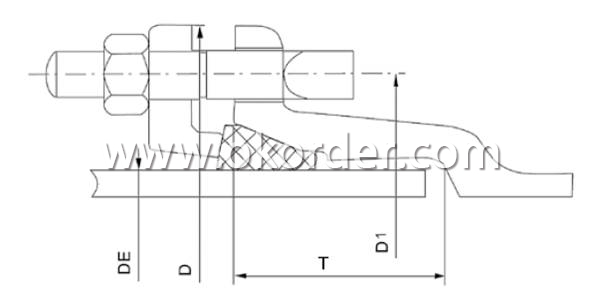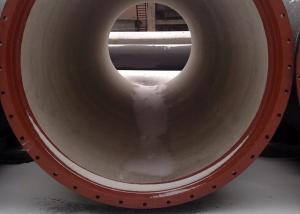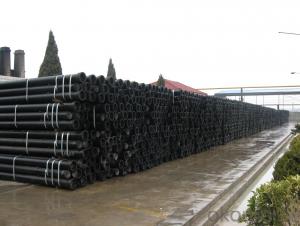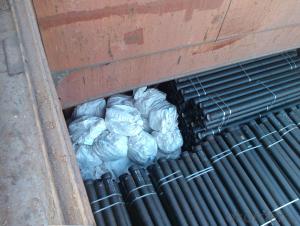Ductile Iron Pipe Mechnical Joint K Type
- Loading Port:
- China Main Port
- Payment Terms:
- TT or LC
- Min Order Qty:
- 100 Meter m
- Supply Capability:
- 250000 Ton Per Year m/month
OKorder Service Pledge
OKorder Financial Service
You Might Also Like
General Introduction & Specifications of Ductile Iron Pipe Mechnical Joint K Type.
Pipes according to ISO2531/EN545
K Type joint
Size: DN80-DN2000
Effective length: 6m/pc or 5.7m/pc or 5.5m/pc
Internal lining: cement mortar lining comply with ISO4179
External coating: sprayed metallic Zinc coating (min.130g/m2) according to ISO8179 + bitumen painting (min.70μm) according to BS3416.
Gasket: Matched 100% natural rubber gasket in accordance with ISO4633.
Standard Wall Thickness of Ductile Iron Pipe Mechnical Joint K Type.
|
Nominal Diameter |
Wall Thickness(mm) | ||||||
|
DN(mm) |
Pipe |
Fittings | |||||
|
Class C |
K8 |
K9 |
K10 |
K12 |
K12 |
K14 | |
|
80 |
4.4 |
6 |
6 |
7 |
8.1 | ||
|
100 |
4.4 |
6.1 |
7.2 |
8.4 | |||
|
125 |
4.5 |
6.3 |
7.5 |
8.8 | |||
|
150 |
4.5 |
6.3 |
7.8 |
9.1 | |||
|
200 |
4.7 |
6.4 |
8.4 |
9.8 | |||
|
250 |
5.5 |
6.8 |
7.5 |
9 |
9 |
10.5 | |
|
300 |
6.2 |
6.4 |
7.2 |
8 |
9.6 |
9.6 |
11.2 |
|
350 |
6.3 |
6.8 |
7.7 |
8.5 |
10.2 |
10.2 |
11.9 |
|
400 |
6.5 |
7.2 |
8.1 |
9 |
10.8 |
10.8 |
12.6 |
|
450 |
6.9 |
7.6 |
8.6 |
9.5 |
11.4 |
11.4 |
13.3 |
|
500 |
7.5 |
8 |
9 |
10 |
12 |
12 |
14 |
|
600 |
8.7 |
8.8 |
9.9 |
11 |
13.2 |
13.2 |
15.4 |
|
700 |
8.6 |
9.6 |
10.8 |
12 |
14.4 |
14.4 |
16.8 |
|
800 |
9.6 |
10.4 |
11.7 |
13 |
15.6 |
15.6 |
18.2 |
|
900 |
11.6 |
11.2 |
12.6 |
14 |
16.8 |
16.8 |
19.6 |
|
1000 |
12.6 |
12 |
13.5 |
15 |
18 |
18 |
21 |
|
1200 |
13.6 |
13.6 |
15.3 |
17 |
20.4 |
20.4 |
22.8 |
|
1400 |
15.7 |
15.2 |
17.1 |
19 |
22.8 |
22.8 |
26.6 |
|
1500 |
16.7 |
16 |
18 |
20 |
24 |
24 |
31 |
|
1600 |
17.7 |
16.8 |
18.9 |
21 |
25.2 |
25.2 |
29.4 |
|
1800 |
19.7 |
18.4 |
20.7 |
23 |
27.6 |
27.6 |
32.2 |
|
2000 |
21.8 |
20 |
22.5 |
25 |
30 |
30 |
35 |
Mechnical Joint of Ductile Iron Pipe Mechnical Joint K Type.

|
Nominal Diameter(DN) |
mm |
Holes No. | |||
|
DE |
D1 |
D |
T | ||
|
100 |
118 |
186 |
232 |
80 |
4 |
|
150 |
170 |
241 |
287 |
80 |
6 |
|
200 |
222 |
292 |
338 |
80 |
6 |
|
250 |
274 |
348 |
394 |
80 |
8 |
|
300 |
326 |
399 |
445 |
110 |
8 |
|
350 |
378 |
458 |
504 |
110 |
10 |
|
400 |
429 |
512 |
558 |
110 |
12 |
|
500 |
532 |
618 |
664 |
110 |
14 |
|
600 |
635 |
725 |
771 |
110 |
14 |
|
700 |
738 |
839 |
893 |
120 |
16 |
|
800 |
842 |
942 |
996 |
120 |
20 |
|
900 |
945 |
1052 |
1118 |
120 |
20 |
|
1000 |
1048 |
1160 |
1226 |
130 |
20 |
|
1200 |
1255 |
1372 |
1438 |
130 |
28 |
|
1400 |
1462 |
1591 |
1657 |
130 |
28 |
|
1600 |
1668 |
1790 |
1856 |
160 |
30 |
|
1800 |
1675 |
1996 |
2062 |
170 |
34 |
|
2000 |
2082 |
2216 |
2282 |
180 |
36 |
Production Flow of Ductile Iron Pipe Mechnical Joint K Type.
Quality raw materials-Molten iron modulation and spheroidizing-Molten iron quality control-centrifugal casting-annealing treatment-performance test-Zinc spraying-hydrostatic testing-cement mortar lining-asphalt spreader-Final inspection packaging warehousing.
Packing and Transportation of Ductile Iron Pipe Mechnical Joint K Type.
Hoisting
Take precaution of handling pipe with steel cable, hoisting belts and specialized rigging avoiding from pipe's rocking. While using steel cable, single cable is not admitted, for the purpose of protecting outer anti-corrosion layer, steel cable should be packed by rubber or other similar material. While using hook, it also should be covered with rubber or other similar material for protecting cement lining layer. Especially for pipe with relative large diameter, hook should be mounted a gasket with same shape as internal diameter of pipes while handling. It is not available fixing hook on the steel belts or socket side and spigot side of pipe while handling pipes in bundle.
Transportation
Put two pieces or more woods on the platform of the vehicle while transporting, pipes are laid on the wood and fixed by wedge. The part over the vehicle body should not be more than 1/4 of overall length of pipe. If pipes are piled up more than one layer, each layer of pipes should reverse, and buffering rubber or gasket should be put on the space between two layers of pipes, at last pipes are fixed up with steel cable and buffering gasket. Check often if pipes can fall out during conveying, and check if stop wedge is not hard up. The vehicle should slow down on the uneven road or while swerving.
Storage
Under pipes there should be put wedge or crosstie while stacking pipes, and socket and spigot of pipes should be interleaved and on the stop wedge in cast of pipe's rolling. Uneven and serious polluted ground, or slope and marshy are not available.
Pictures Show of Ductile Iron Pipe Mechnical Joint K Type.


If you have other question about our products, please feel free to consult us directly.
- Q:Can ductile iron pipes be used for firefighting systems?
- Ductile iron pipes are capable of being utilized in firefighting systems. This material, known for its strength and resilience, can withstand intense pressures and extreme temperatures, thereby making it a suitable option for transporting water in such systems. Moreover, the pipes' resistance to corrosion and ability to handle external loads guarantee their long-term dependability and effectiveness. Furthermore, ductile iron pipes possess exceptional fire-resistant qualities, as they are non-combustible, do not emit harmful fumes, and do not contribute to the propagation of fire. Consequently, due to their robustness, durability, and fire resistance, ductile iron pipes are widely chosen and trusted for firefighting systems.
- Q:Are ductile iron pipes suitable for installation in rocky or hard soil conditions?
- Yes, ductile iron pipes are suitable for installation in rocky or hard soil conditions. Ductile iron has excellent strength and durability, making it highly resistant to external pressures and impacts. It can withstand the challenges posed by rocky or hard soils, ensuring reliable and long-lasting performance.
- Q:How does ductile iron pipe perform in areas with high soil movement?
- Ductile iron pipe possesses notable attributes of strength, durability, and flexibility, rendering it an optimal selection for locales with substantial soil movement. Differing from alternative piping materials, like PVC or concrete, ductile iron pipe demonstrates the capability to endure significant ground shifts without undergoing catastrophic failure. The inherent robustness of ductile iron pipe empowers it to withstand the external forces imposed by soil movement, encompassing settlement, lateral displacement, and ground heave. Its elevated tensile strength and capacity to endure bending stresses render it less prone to developing cracks, fractures, or leaks, thereby ensuring the pipeline system's integrity. Moreover, ductile iron pipe exhibits remarkable deflection capabilities, imparting the capacity to flex and accommodate ground movement without succumbing to breakage. This flexural aptitude enables the pipe to disseminate the stress engendered by soil movement along its length, thereby diminishing the concentration of forces at any specific juncture. In regions characterized by pronounced soil movement, ductile iron pipe also reaps the advantages of its corrosion resistance properties. Typically coated with a protective layer, such as cement-mortar lining or polyethylene encasement, the pipe serves as a barrier against corrosive elements found in the soil. This protective coating effectively mitigates damage and deterioration, ensuring the pipe's endurance and performance, even in demanding soil conditions. All in all, ductile iron pipe is highly recommended for locales with substantial soil movement due to its exceptional strength, flexibility, and corrosion resistance. Its ability to withstand ground shifts and distribute stress establishes it as a dependable choice for long-term performance, necessitating minimal maintenance.
- Q:Can ductile iron pipes be used for wastewater treatment plants?
- Indeed, ductile iron pipes have proven to be a viable option for wastewater treatment plants. Renowned for their robustness and endurance, these pipes are well-suited to endure the challenging and corrosive conditions present in such facilities. They possess the ability to withstand elevated pressures and exhibit resistance against corrosion, which is crucial for effectively managing wastewater and the diverse range of chemicals utilized in the treatment procedure. Additionally, ductile iron pipes offer the advantage of being effortless to install and maintain, ensuring an extended period of service. Consequently, they are frequently utilized in wastewater treatment plants for the transportation and distribution of wastewater across the entirety of the establishment.
- Q:Can ductile iron pipe be used for directional drilling?
- Yes, ductile iron pipe can be used for directional drilling. Directional drilling is a technique used to install underground pipes, cables, and conduits in a curved or horizontal path. Ductile iron pipes are known for their high strength and flexibility, making them suitable for this method. The pipes can be easily bent and maneuvered during the drilling process, allowing for the installation of pipelines in challenging terrains or crossing obstacles such as rivers, highways, and buildings. Additionally, ductile iron pipes have excellent resistance to corrosion, making them a durable and reliable choice for directional drilling projects.
- Q:Are ductile iron pipes resistant to biogenic sulfide corrosion?
- Yes, ductile iron pipes are resistant to biogenic sulfide corrosion. The high strength and durability of ductile iron make it highly resistant to the corrosive effects of biogenic sulfide, making it an ideal choice for underground sewer and wastewater applications.
- Q:Can ductile iron pipes be used for underground steam distribution systems?
- Yes, ductile iron pipes can be used for underground steam distribution systems. Ductile iron has excellent strength, durability, and resistance to high temperatures, making it suitable for carrying steam underground. Additionally, its corrosion resistance properties ensure a longer lifespan and reduced maintenance costs.
- Q:Can ductile iron pipe be used for gas distribution systems?
- Yes, ductile iron pipe can be used for gas distribution systems. Ductile iron is a strong and durable material that is resistant to corrosion, making it suitable for underground applications. It has been widely used in gas distribution systems for many years due to its ability to withstand high pressure and provide a reliable and long-lasting solution. Additionally, ductile iron pipes are known for their flexibility, which allows for easier installation and maintenance. However, it is important to ensure that the specific requirements and standards of gas distribution systems are met when using ductile iron pipes to ensure the safety and efficiency of the system.
- Q:The difference between spheroidal graphite cast iron pipe and HDPE water supply pipe
- As the HDPE pipe is made of hot melt connection, the construction is more difficult, and the installation cost is about 40% higher than that of the nodular cast iron pipe.
- Q:Can ductile iron pipe be used for irrigation pumping stations?
- Yes, ductile iron pipe can be used for irrigation pumping stations. Ductile iron pipe is commonly used in various applications, including irrigation systems, due to its durability and strength. It has high tensile strength and can withstand high pressure and heavy loads, making it suitable for irrigation pumping stations. Additionally, ductile iron pipe is resistant to corrosion, which is beneficial in irrigation systems where water is present. It is also easy to install and maintain, making it a cost-effective choice for irrigation projects.
1. Manufacturer Overview |
|
|---|---|
| Location | Shandong, China |
| Year Established | 1989 |
| Annual Output Value | Above US$ 3 Million |
| Main Markets | Mid East Europe; Eastern Asia; South Africa; |
| Company Certifications | ISO 9001:2008;ISO2531:2000 |
2. Manufacturer Certificates |
|
|---|---|
| a) Certification Name | |
| Range | |
| Reference | |
| Validity Period | |
3. Manufacturer Capability |
|
|---|---|
| a)Trade Capacity | |
| Nearest Port | Tianjin; Qingdao |
| Export Percentage | 41% - 50% |
| No.of Employees in Trade Department | 2000 People |
| Language Spoken: | English; Chinese; Spain; Alabic |
| b)Factory Information | |
| Factory Size: | Above 100,000 square meters |
| No. of Production Lines | Above 8 |
| Contract Manufacturing | OEM Service Offered; Design Service Offered |
| Product Price Range | Average |
Send your message to us
Ductile Iron Pipe Mechnical Joint K Type
- Loading Port:
- China Main Port
- Payment Terms:
- TT or LC
- Min Order Qty:
- 100 Meter m
- Supply Capability:
- 250000 Ton Per Year m/month
OKorder Service Pledge
OKorder Financial Service
Similar products
New products
Hot products
Hot Searches
Related keywords



























